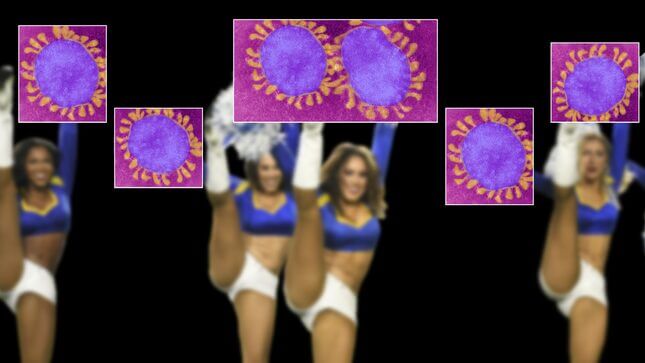How the NFL Risks the Health of Cheerleaders, Its Hardest Working, Lowest Paid Women
Latest
Illustration: Elena Scotti (Photos: Getty Images)
Watching NFL cheerleaders perform for limited or nonexistent crowds with masks obscuring their white strip-sponsored smiles was one of the more off-putting spectacles of 2020. In spite of the coronavirus pandemic, they waved pom-poms and danced, all with unflinching loyalty to the godforsaken game of football.
But the uncanny presence of cheerleaders during a global health meltdown snowballed into something more ominous when two individuals with knowledge of the Los Angeles Rams said that the organization was not providing or requiring covid-19 tests for its cheerleaders throughout 2020.
Jezebel has obtained a copy of the covid-19 guidelines sent to the Rams cheerleaders following Labor Day weekend. The memo does not require the cheerleaders to remain isolated, nor does it mention testing or the possibility of asymptomatic exposure, placing a disproportionate amount of responsibility on the cheerleaders to keep themselves safe. The team, however, began issuing tests for select cheerleaders participating in one-off promotional events around the time the Rams’ season ended in January.
In a statement to Jezebel, a representative for the Rams said that the “health and safety of our staff are our top priorities.” The statement continued:
Adhering to the health guidelines provided by local and state officials, as well as the National Football League, we adjusted our operations and processes this year to keep our staff healthy and deter the spread of COVID-19.
As it relates to our cheerleaders, all gameday and community appearances were voluntary and that was communicated to the entire cheerleading team and reinforced throughout the season. Those who chose to participate in any in-person opportunities were required to follow local and state guidelines, including wearing a mask and proper social distancing. Rehearsals were limited to no more than eight cheerleaders in the studio at once, with everyone else participating virtually. We also offered virtual opportunities for our cheerleaders to engage with fans and the community throughout the season. In addition, in anticipation of the Thanksgiving holiday, we proactively eliminated gameday Cheerleader performances beginning with our November 29 home game (ahead of California’s stay-at-home order that was implemented on December 8).
While we followed the COVID-19 testing regulations provided by the NFL and NFLPA for players, coaches and tiered staff (as determined by the NFL), the majority of our staff, including many who worked gamedays and community events, did not fall into these testing protocols.
As the Rams’ statement noted, many of those employed by the organization were not tested. The lack of regular testing for cheerleaders is alarming considering that players, coaches, and other “Tier 1 and Tier 2” staff receive daily PCR tests, as mandated by the NFL’s COVID Protocols. Within the same 78-page document, cheerleaders are mentioned just once to declare that they will not have “field access at any time,” leaving cheer programs all but abandoned in an unregulated, wild west. With testing infrastructure already in place, the cheerleaders were forgotten—or worse, ignored.
Forgettable, but apparently still important: 25 of the 26 NFL cheer teams hired cheerleaders this season (the Chargers did not rehire their cheerleaders, and several teams halted game-day operations mid-season). Of them, not a single team has made a public statement regarding testing, except for the Dallas Cowboys, who tested their cheerleaders three times a week inside a bubble in order to continue production of their profitable reality show “Dallas Cowboys Cheerleaders: Making the Team.”
Until November 29, just before LA County issued its Safer at Home Order, the team of 32 Rams cheerleaders had been conducting some practices, performances, and events in-person—mostly socially distant and masked, but not always—resulting in frequent exposure to each other and to members of the LA community. Given that Los Angeles was averaging 14,120 cases per day in early December, coupled with the climbing number of active outbreaks across the league, the cheerleaders ran a significant risk of contracting the virus.
Dr. Peter Katona, a Professor of Medicine at UCLA’s David Geffen School of Medicine and Adjunct Professor of Public Health at the UCLA Fielding School of Public Health, said, “Masking, assuming you’re doing the masking appropriately, is a good thing, being outside is a good thing, but being close to each other and also breathing heavily—this is an athletic activity, so your breath rate is increased—[is] a mixed bag of risk that is not ideal, but not terrible.”
-

-

-

-

-

-

-

-

-

-

-

-

-

-

-

-

-

-

-

-

-

-

-

-

-

-

-

-

-

-

-

-

-

-

-

-

-

-

-

-









































